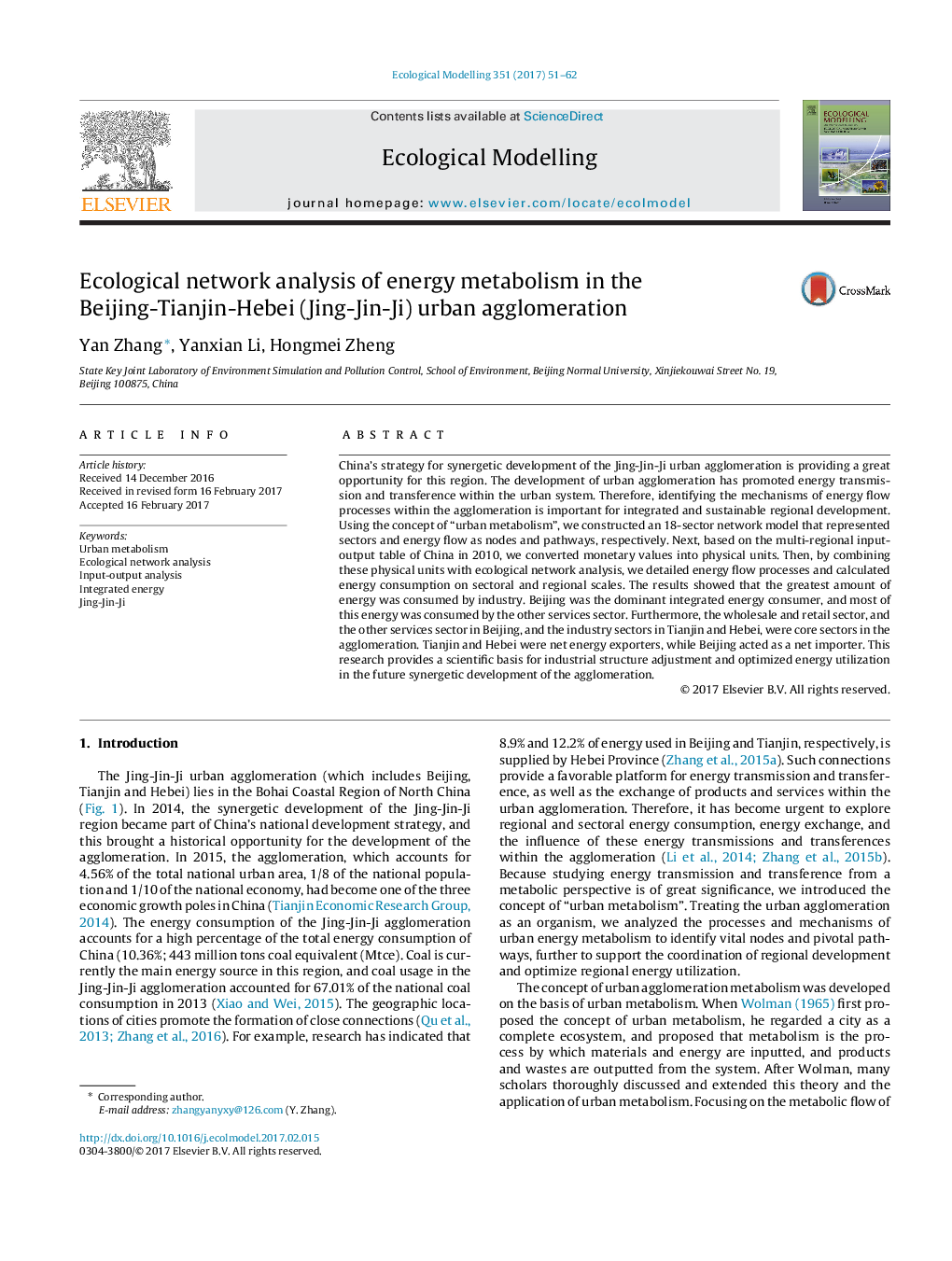| کد مقاله | کد نشریه | سال انتشار | مقاله انگلیسی | نسخه تمام متن |
|---|---|---|---|---|
| 5742219 | 1617396 | 2017 | 12 صفحه PDF | دانلود رایگان |
عنوان انگلیسی مقاله ISI
Ecological network analysis of energy metabolism in the Beijing-Tianjin-Hebei (Jing-Jin-Ji) urban agglomeration
ترجمه فارسی عنوان
تجزیه و تحلیل شبکه اکولوژیکی متابولیسم انرژی در تجمعات شهری پکن-تیانجین-هبی (جینگ جین جی)
دانلود مقاله + سفارش ترجمه
دانلود مقاله ISI انگلیسی
رایگان برای ایرانیان
کلمات کلیدی
متابولیسم شهری، تجزیه و تحلیل شبکه محیط زیست، تجزیه و تحلیل ورودی-خروجی، انرژی مجتمع، جینگ جین جی،
ترجمه چکیده
استراتژی چین برای توسعه هماهنگی تجمعات شهری جینگ جین جی فرصتی عالی برای این منطقه است. توسعه شهرک سازی شهری، انتقال و انتقال انرژی را در داخل سیستم شهری ارتقاء داده است. بنابراین شناسایی مکانیسم های فرآیند جریان انرژی در محوطه سازی برای توسعه یکپارچه و پایدار منطقه ای مهم است. با استفاده از مفهوم متابولیسم شهری، ما یک مدل شبکه 18 بخش تشکیل دادیم که به ترتیب بخش ها و جریان انرژی را به صورت گره ها و مسیرها نشان می داد. بعد، بر اساس جدول ورودی-خروجی چند منطقه ای چین در سال 2010، ارزش پولی ما را به واحد های فیزیکی تبدیل کردیم. سپس، با ترکیب این واحدهای فیزیکی با تجزیه و تحلیل شبکه های اکولوژیکی، فرایندهای جریان انرژی دقیق و مصرف انرژی محاسبه شده در مقیاس های منطقه ای و منطقه ای را در بر می گیرد. نتایج نشان داد که بیشترین میزان انرژی توسط صنعت مصرف شد. پکن مصرف کننده انرژی مجتمع غالب بود و اکثر این انرژی توسط بخش خدمات دیگر مصرف شد. علاوه بر این، بخش عمده فروشی و خرده فروشی، و بخش خدمات دیگر در پکن و بخش های صنعت در تیانجین و هبی، بخش اصلی در این شهر بودند. تیانجین و هبی صادر کننده انرژی خالص بودند، در حالی که پکن به عنوان وارد کننده خالص عمل می کرد. این تحقیق زمینه پایه ای برای تنظیم ساختار صنعتی و بهینه سازی استفاده از انرژی در توسعه هماهنگی آگلومره را فراهم می کند.
موضوعات مرتبط
علوم زیستی و بیوفناوری
علوم کشاورزی و بیولوژیک
بوم شناسی، تکامل، رفتار و سامانه شناسی
چکیده انگلیسی
China's strategy for synergetic development of the Jing-Jin-Ji urban agglomeration is providing a great opportunity for this region. The development of urban agglomeration has promoted energy transmission and transference within the urban system. Therefore, identifying the mechanisms of energy flow processes within the agglomeration is important for integrated and sustainable regional development. Using the concept of “urban metabolism”, we constructed an 18-sector network model that represented sectors and energy flow as nodes and pathways, respectively. Next, based on the multi-regional input-output table of China in 2010, we converted monetary values into physical units. Then, by combining these physical units with ecological network analysis, we detailed energy flow processes and calculated energy consumption on sectoral and regional scales. The results showed that the greatest amount of energy was consumed by industry. Beijing was the dominant integrated energy consumer, and most of this energy was consumed by the other services sector. Furthermore, the wholesale and retail sector, and the other services sector in Beijing, and the industry sectors in Tianjin and Hebei, were core sectors in the agglomeration. Tianjin and Hebei were net energy exporters, while Beijing acted as a net importer. This research provides a scientific basis for industrial structure adjustment and optimized energy utilization in the future synergetic development of the agglomeration.
ناشر
Database: Elsevier - ScienceDirect (ساینس دایرکت)
Journal: Ecological Modelling - Volume 351, 10 May 2017, Pages 51-62
Journal: Ecological Modelling - Volume 351, 10 May 2017, Pages 51-62
نویسندگان
Yan Zhang, Yanxian Li, Hongmei Zheng,
